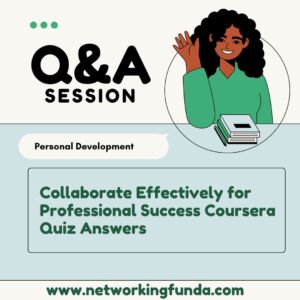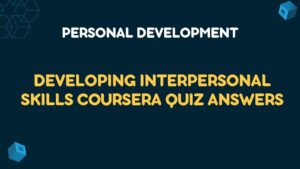Table of Contents
Get All Weeks How to Manage a Remote Team Coursera Quiz Answers
Week 01: How to Manage a Remote Team Coursera Quiz Answers
About Remote Work Quiz Answers
Q1. True or false: Remote workers tend to have a more flexible schedule.
Q2. There are many definitions of what it means to work remotely. The simplest definition of remote work is:
ViewQ3. According to GitLab’s Remote Work Report, what was the top benefit of working remotely?
ViewQ4. There are several key requirements you need to consider when transitioning to remote. Which requirement sends a clear signal to your team that a remote transition is underway?
ViewBuilding a Team Quiz Answers
Q1. True or false: To attract a global pool of candidates, post a remote job opportunity exactly the same as you would post it for local candidates to avoid bias.
ViewQ2. What is the first step to preparing your recruiters to effectively hire for a remote role?
ViewQ3. There are many changes that take place when moving to a fully distributed environment. Your People or HR team will likely experience the following changes:
ViewQ4. Select every interview question that is recommended for a remote job interview.
View2.”Have you ever worked independently without direct supervision on a daily basis?”
3.”How do you switch off from work?”
Remote Work Best Practices Quiz Answers
Q1. True or false: Employees find themselves to be more productive in a remote environment.
ViewQ2. True or false: To qualify as a remote worker, you must spend most of your time working
Viewfrom home.
Q3. Values that bind people are essential for remote teams. Why is it important to hire for values, instead of focusing on a candidate’s culture fit?
ViewQ4. True or false: When hiring for a remote role, give preference to people with strong communication skills.
ViewQ5. Nadia is working from home for the first time and lacks some of the basic office equipment needed to be productive. To make sure she is set up for success, what step should her manager take?
ViewQ6. Select all the components that are important for a functional workspace.
View2.Decent noise control
3.A dedicated space they use all the time for work
4.Good lighting Good lighting
Q7. What is the most important thing you can do when onboarding a new team member remotely?
ViewQ8. As a leader, transitioning from a colocated environment to a distributed one, there are many shifts in HR tactics you’ll need to facilitate. Select all of the HR practices that support remote readiness.
View2.Offer a mental wellness support plan with counseling benefits.
3.Create a set of best practices for scheduling meetings across time zones.
Week 02: How to Manage a Remote Team Coursera Quiz Answers
Communication Quiz Answers
Q1. When working asynchronously, it is important to use ____________ communication.
ViewQ2. Asynchronous communication is the art of…
ViewQ3. Practicing iteration means:
ViewPersonal Development and Leadership Quiz Answers
Q1. Feedback should be given___________________.
ViewQ2. True or false: Hybrid calls, with some participants remote and others in an office together, should be avoided.
ViewQ3. Remote workers need to be ______________ about where they want to go in their career than colocated employees.
ViewQ4. True or false: If you have good communication and documentation strategies, it becomes much easier to implement strong project and task management.
ViewManaging Remote Teams Quiz Answers
Q1. True or false: When you work asynchronously, you have to answer messages right away.
ViewQ2. Tactics that can be used to support effective meetings include:
View2.Every meeting has a written agenda.
Q3. True or false: Early-stage startups are less likely to need a strong documentation strategy.
ViewQ4. When assessing your team’s performance, what you really want to know is:
ViewQ5. True or false: OKRs help with collaboration because there’s a transparent understanding of objectives.
ViewQ6. Which of the below practices are part of good project management?
View2.Label hygiene
Q7. Remote teams should aim to __________ their tool stack.
ViewQ8. Leaders should be advocates of ________________.
ViewRemote Adaptation Quiz Answers
Q1. The process of adopting remote practices is _____________.
ViewQ2. The process of going remote requires:
ViewQ3. The most difficult remote structure to implement and maintain is _______.
ViewQ4. Afua has been a successful manager at a colocated organization. Her company has just transitioned to a remote-first team structure. What is a likely problem that Afua might experience?
ViewQ5. True or false: An organization in the asynchronous phase of remote adaptation is characterized by a centralized, single source of truth documentation system that is easily accessed and kept up to date.
ViewQ6. When leaders begin to ask “what if we didn’t do things the way we’ve always done them?” this is a sign that the organization is ready to enter the ____________ phase of remote adaptation.
ViewQ7. For an organization to reach maturity, it should master certain remote-specific practices:
View2.Leadership and management transparency
Q8. An organization has been engaged in a remote transition for several months when they identify an unplanned and unexpected risk. What is the best approach to this?
ViewQ9. As a leader transitioning a co-located organization to a remote one, what are some of the ideas you can implement to reassure employees and get their buy-in?
View2.Host Ask Me Anything sessions to get feedback and answer questions
Culture and Values for Distributed Teams Quiz Answers
Q1. Culture is a system of values and beliefs, which guides people to act in certain ways through establishing ________________.
ViewQ2. Burnout and overwork are __________ in a remote environment.
ViewQ3. True or false: A strong company culture is a natural result of having a strong business strategy.
ViewQ4. Which of the following statements is true?
ViewQ5. Values are not:
ViewQ6. HR professionals should be able to advise on how values will be perceived ____________, and your advisory board can advise on how they will be perceived ____________.
ViewQ7. The greatest resource for determining your values are the ___________ who make up your organization.
ViewQ8. Because your values should support your _______________, they can be reassessed in that context.
ViewFind More Related Quiz Answers >>
Collaborate Effectively for Professional Success Coursera Quiz Answers
Developing Interpersonal Skills Coursera Quiz Answers
Solving Problems with Creative and Critical Thinking Quiz Answers





